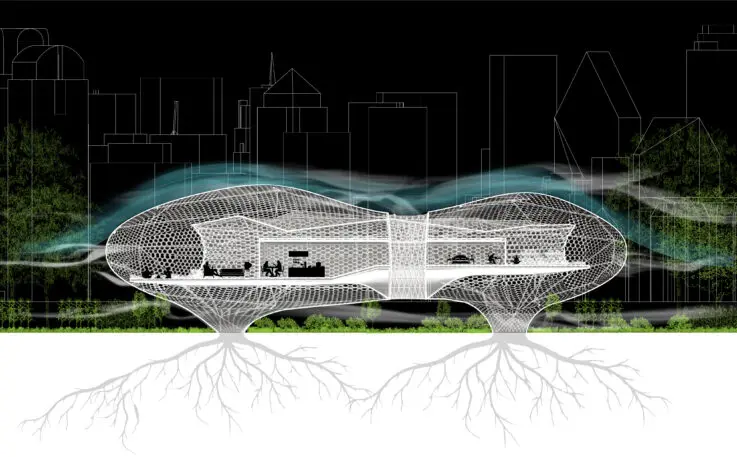This story is part of Home Bound, a series that examines Americans’ fraught relationship with their homes—and the once-in-a-lifetime opportunity to hit the reset button. Read more here.
Flip on HGTV, and you’ll learn the biggest challenge of creating your dream home comes down to selecting the right couch and kitchen countertops. Maybe you’ll need to knock down a few walls in order to transform an older house into an open concept. Maybe you’ll put a big TV in the basement next to a bar and dub it the man cave.
But 2020 changed everything we thought we needed in a house. As groceries arrived at my door, I scrubbed milk cartons and canned beans in case COVID-19 was lurking on their surfaces. As Amazon packages were dropped off, they lived in a basement bathroom for three days before being opened. As I exercised from home, my bike took up permanent residence inside, on a trainer. And as my son attended classes virtually, our kitchen table became his schoolroom. Letter and number charts live right on my pantry door.
Suffice it to say, I never imagined my home looking like this, full of boxes, bulky exercise contraptions, and alphabets—and you probably didn’t imagine yours this way either! But the truth is that this is what we do in times of need: We adapt. And the architecture of our home is no different.
The question is, how should our homes adapt? To answer that question for our Home Bound editorial package, I didn’t turn on HGTV. Instead, I reached out to two lauded architecture and design firms, Perkins&Will and Perkins Eastman. I gave them each a challenge: In light of the global pandemic and all of the changes that have come along with it, design me the home of the future. Its technology can be about five to 10 years out. Otherwise, the sky’s the limit.
What the two firms created are vastly different, but equally compelling visions. They leverage technology, designed to respond to our needs without thought, making us healthier, happier, and all around safer than our homes make us today.
The Pulmo House (aka the Lung)
Perkins&Will developed a concept it’s dubbed the Pulmo House, or the Lung. The idea is that it’s a living, breathing home, built with walls that literally filter out the bad stuff, be it germs or digital misinformation.
Architect Le Corbusier once called the home “a machine for living in.” The Pulmo House is more like a life-form for living in.
(And yes, that means Perkins&Will appears to have thought more than a decade out with this concept, but it’s hard not to be smitten.)

The Lung is basically a giant cell, with a semipermeable membrane on the outside serving as the walls. This membrane is built from several gauzy layers. These layers let in fresh air, because we know that indoor air quality can be dirtier than air in the most polluted cities. Perkins&Will also imagines that these walls could somehow filter, screen, and quarantine delivered packages, too. What would the walls be made of to accomplish all this, and still keep our homes warm at night? Try not to let those reasonable, unresolved details get in the way of the broader vision.
You’ll notice that the home is largely transparent, and it’s supposed to be. While being stuck at home can be isolating, and the Pulmo House has been designed largely to keep bad things out, it also is designed to connect you to the greater world.
Then, underneath the home are deep roots that grow into the ground, in lieu of a more traditional concrete foundation. These roots are literal, growing from our homes into the ground.
“It is a reference to the way the building interacts with the earth in a symbiotic way . . . versus an aggressive mode of piercing the earth and extracting,” the architects write. “Sensors to understand hydrology, geological movement, soil conditions, etc., AND to exchange nutrients—ways of exchanging resources (not unlike the way the lung deals with gas exchange).”
Fresh air, sterile packages, and some sort of technological mechanism that filters out the worst of my Twitter feed? I’ll take it.
The Nudge Home
If the Pulmo House was a vision of what a home could be if buildings got out of the way of nature, the Nudge Home, by Perkins Eastman, is in many ways the opposite. It’s a building that’s been programmed to change the behaviors of its occupants, constantly pushing us to live healthier, more sustainable lives. It’s the home as a machine, taken to the max.
The basic blueprint of the Nudge Home is as a sustainable ranch home. It’s topped with solar and wind power generators. It collects its own rainwater. It has hydroponic walls and even a garden that reaches into the street to grow some of its own food. And it is also a giant computer. The home is loaded with sensors to track human and plant activity, while walls and windows double as interactive touchscreens.
When you bring all these elements together, you have a home that can recognize your state, and do something to improve it—all without using pesky push notifications on your phone. Instead, the home subtly nudges you to make the best decision. Perkins Eastman offers three specific examples of how this would work.
[Perkins Eastman]
In the first example, a person works in their home office. It’s been a while since they got up. So a window to the outside boosts the colors of green space and blue sky outside. It essentially Instagram filters nature! And in doing so, it doesn’t tell the person to go on a walk, it nudges them to.
[Perkins Eastman]
In the firm’s second example, it’s dinnertime, and a person walks by the fridge. The house uses its sensors to cross-reference what’s growing in the garden and what’s in the fridge, with recipes in a database. It then suggests one meal that could be made for dinner, pasting the recipe right over the nearby window. The idea is by offering someone one option that’s good for their health, budget, and environment, they’d just go with it.
[Perkins Eastman]The final example is a child’s room. A girl sits playing at her computer when the house recognizes she’s been playing video games for too long. The house scans outside for a nature play mode, and spots a group of birds. The house then transforms the windows into an interactive interface to design birds nests. (And if the child would like to actually build one, the materials have been stored at a local park.) Whether she chooses to stay home and design birds nests out of her window, or walk to the park to do it in person, both options offer her a small taste of nature.
Ultimately, the Pulmo House and the Nudge Home push the limits of technology and design in vastly different directions. But I’d argue that each home is enticing because, above all else, it puts the needs of its occupants first. Each is working dynamically, 24/7, to protect and enrich both our lives and our relationship with our planet.
Recognize your brand’s excellence by applying to this year’s Brands That Matter Awards before the early-rate deadline, May 3.
